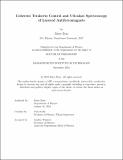| dc.description.abstract | The central theme of modern condensed matter physics is to understand the emergent phenomena arising from interactions among Avogadro’s number of particles in quantum materials, alongside efforts to control their properties. While powerful transport, thermodynamic, and spectroscopic tools have been developed, they often fall short to reveal the intricate interplay among electronic, spin, orbital, and lattice degrees of freedom. A promising approach involves selectively perturbing one degree of freedom while observing responses in others, made possible by ultrafast lasers with femtosecond time resolution. These advancements not only showcase the capability of ultrafast experiments in understanding complex material properties but also demonstrate the manipulation of ordered phases at ultrafast timescales, thereby opening a laboratory for studying materials in nonequilibrium regime. This dissertation contributes to the ongoing effort of developing new ultrafast spectroscopy tools, utilizing them to probe lattice, magnetic, and electronic properties, and gaining active control over them. Specifically, it investigates the induction of a new magnetic state with net magnetization using intense low-energy terahertz (THz) pulses in the van der Waals antiferromagnet FePS₃. Critical fluctuations near the phase transition are found to enhance both the magnitude and the lifetime of this new state. Additionally, a broadband two-dimensional (2D) THz spectroscopy technique is developed and employed to study interactions among low-energy collective excitations and to directly identify phonons that induce the new magnetic phase. Furthermore, time-resolved spectroscopy in the visible and near-infrared spectral range is utilized to detect a bound state between phonon and electronic states in the sister compound NiPS₃, and to capture a magnetostriction effect in FePS₃ using coherent phonon spectroscopy, that was elusive to conventional diffraction experiments. Finally, second harmonic generation spectroscopy with microscale spatial resolution, is employed to study the multiferroic material NiI₂, demonstrating its persistence down to the single atomic layer — a first of its kind. These findings and tools can potentially be extended to frustrated quantum magnets to control their magnetic phases and potentially detect their collective modes. The 2D nonlinear spectroscopy utilized in this dissertation is gaining attention both theoretically and experimentally as a promising tool for detecting fractionalized spin excitations. | |
